深圳小学六年级英语语法大全分析
- 格式:doc
- 大小:77.50 KB
- 文档页数:12
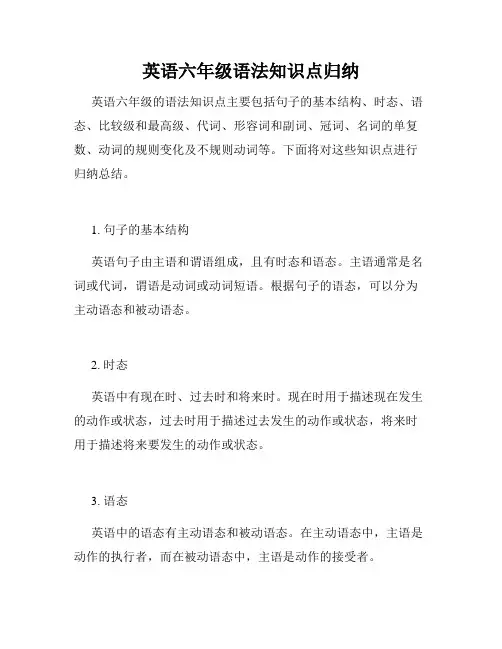
英语六年级语法知识点归纳英语六年级的语法知识点主要包括句子的基本结构、时态、语态、比较级和最高级、代词、形容词和副词、冠词、名词的单复数、动词的规则变化及不规则动词等。
下面将对这些知识点进行归纳总结。
1. 句子的基本结构英语句子由主语和谓语组成,且有时态和语态。
主语通常是名词或代词,谓语是动词或动词短语。
根据句子的语态,可以分为主动语态和被动语态。
2. 时态英语中有现在时、过去时和将来时。
现在时用于描述现在发生的动作或状态,过去时用于描述过去发生的动作或状态,将来时用于描述将来要发生的动作或状态。
3. 语态英语中的语态有主动语态和被动语态。
在主动语态中,主语是动作的执行者,而在被动语态中,主语是动作的接受者。
4. 比较级和最高级比较级用于表示两者之间的比较,最高级用于表示三者或三者以上的比较。
比较级的构成通常在形容词或副词前加上更或-er,最高级的构成通常在形容词或副词前加上最或-est。
5. 代词代词用于替代名词,常见的代词有人称代词、物主代词、指示代词、不定代词等。
6. 形容词和副词形容词用于修饰名词,副词用于修饰动词、形容词或其他副词。
形容词的比较级和最高级可以通过在后面加上-er和-est来构成,副词的比较级和最高级则通常在前面加上more和most。
7. 冠词英语中的冠词包括定冠词和不定冠词。
定冠词the用于特指某个人或物,不定冠词a/an用于泛指某个人或物。
8. 名词的单复数名词分为可数名词和不可数名词,可数名词有单数和复数两种形式,不可数名词只有单数形式。
复数名词的构成通常在单数名词后加上-s或-es。
9. 动词的规则变化及不规则动词动词根据时态和人称的不同,有时需要进行规则变化。
规则变化通常在动词原形后加上-s、-ed或-ing等。
但有一些动词是不规则的,它们的变化形式需要特别记忆。
这些就是英语六年级的语法知识点的基本归纳。
熟练掌握这些知识点,将有助于提高英语的语法水平,并在写作和口语表达中更准确地运用。
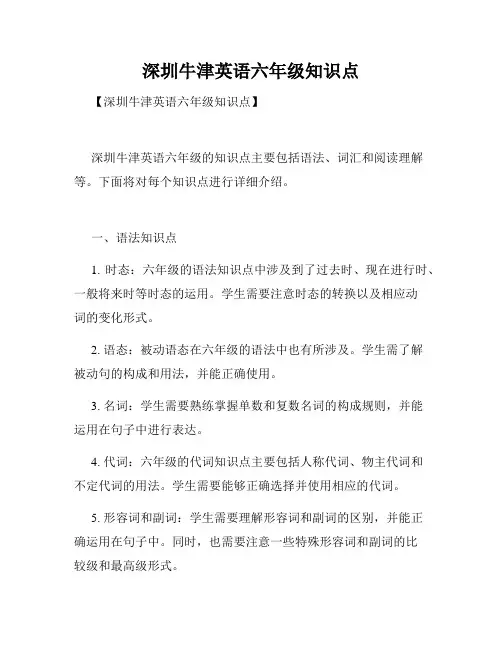
深圳牛津英语六年级知识点【深圳牛津英语六年级知识点】深圳牛津英语六年级的知识点主要包括语法、词汇和阅读理解等。
下面将对每个知识点进行详细介绍。
一、语法知识点1. 时态:六年级的语法知识点中涉及到了过去时、现在进行时、一般将来时等时态的运用。
学生需要注意时态的转换以及相应动词的变化形式。
2. 语态:被动语态在六年级的语法中也有所涉及。
学生需了解被动句的构成和用法,并能正确使用。
3. 名词:学生需要熟练掌握单数和复数名词的构成规则,并能运用在句子中进行表达。
4. 代词:六年级的代词知识点主要包括人称代词、物主代词和不定代词的用法。
学生需要能够正确选择并使用相应的代词。
5. 形容词和副词:学生需要理解形容词和副词的区别,并能正确运用在句子中。
同时,也需要注意一些特殊形容词和副词的比较级和最高级形式。
6. 连词:学生需要掌握一些常见的并列连词和转折连词的使用方法,使句子表达更加准确清晰。
二、词汇知识点1. 基础词汇:六年级的词汇知识点主要包括食物、动物、身体部位、自然现象、时间、数词等。
学生需要通过词汇的积累和运用,积极扩大自己的词汇量。
2. 常见短语:六年级的常见短语知识点涉及到日常生活、校园生活、节日庆祝等方面。
学生需要逐步熟练运用这些短语,让语言更加地道自然。
3. 同义词和反义词:学生需要学会从上下文中寻找同义词和反义词,提高英语阅读理解的能力。
三、阅读理解六年级的阅读理解要求学生能够读懂一些简单的英语文章,并能回答相关问题。
阅读材料可以包括日常对话、短文、海报等形式。
学生需要通过大量的阅读练习,提高自己的阅读理解能力。
总结:深圳牛津英语六年级的知识点主要包括语法、词汇和阅读理解等方面。
学生需要通过反复练习,逐渐掌握并灵活运用这些知识点。
只有在实践中不断巩固,才能使自己的英语水平不断提高。
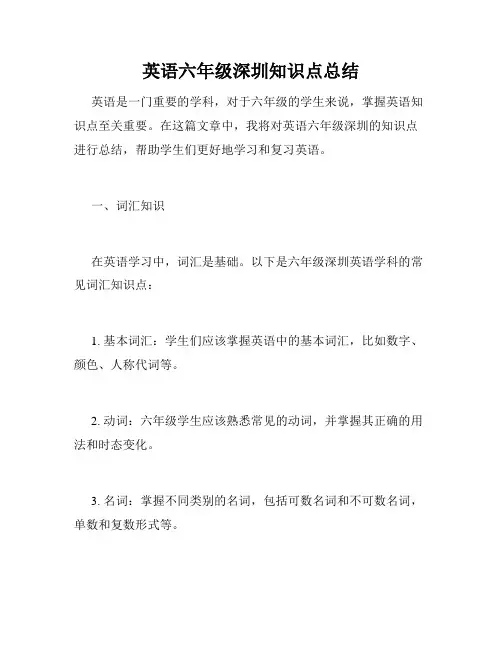
英语六年级深圳知识点总结英语是一门重要的学科,对于六年级的学生来说,掌握英语知识点至关重要。
在这篇文章中,我将对英语六年级深圳的知识点进行总结,帮助学生们更好地学习和复习英语。
一、词汇知识在英语学习中,词汇是基础。
以下是六年级深圳英语学科的常见词汇知识点:1. 基本词汇:学生们应该掌握英语中的基本词汇,比如数字、颜色、人称代词等。
2. 动词:六年级学生应该熟悉常见的动词,并掌握其正确的用法和时态变化。
3. 名词:掌握不同类别的名词,包括可数名词和不可数名词,单数和复数形式等。
4. 形容词和副词:学生们需要学会用形容词和副词来描述人、事、物的特征和状态,并了解其比较级和最高级的形式。
二、语法知识学习好英语除了词汇,还需要掌握一些基本的语法知识。
以下是六年级深圳英语的常见语法知识点:1. 时态:学生们需要掌握英语中的基本时态,比如一般现在时、一般过去时和一般将来时等。
2. 句型:六年级学生应该熟悉基本的句型结构,包括陈述句、疑问句、否定句等,在口语和书面表达中正确运用。
3. 代词:了解不同类型的代词,包括人称代词、物主代词、反身代词等,并知道它们的用法和形式。
4. 介词:熟悉常见的介词,并了解介词与名词、动词、形容词之间的搭配关系。
三、阅读理解阅读理解是英语学习的重要部分。
以下是六年级深圳英语的阅读理解知识点:1. 理解短文:学生们需要通过阅读短文来获取信息,并回答与文章内容相关的问题。
了解如何从文章中寻找答案是阅读理解的核心。
2. 掌握关键词:在阅读理解中,学生们需要通过寻找关键词来理解文章的主题和细节。
掌握关键词能够帮助学生更好地理解文章,并准确回答问题。
3. 推理判断:阅读理解也涉及到学生的推理和判断能力。
学生们需要通过已有的信息来推测未知的信息,并进行正确的判断。
四、口语表达除了阅读理解,口语表达也是英语学习的重要部分。
以下是六年级深圳英语口语表达的知识点:1. 日常交流:学生们应该掌握一些日常交流的口语表达,比如问候、告别、请求、感谢等。
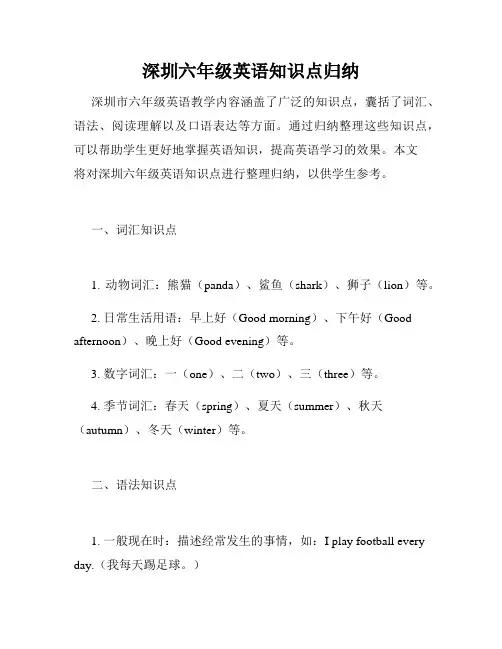
深圳六年级英语知识点归纳深圳市六年级英语教学内容涵盖了广泛的知识点,囊括了词汇、语法、阅读理解以及口语表达等方面。
通过归纳整理这些知识点,可以帮助学生更好地掌握英语知识,提高英语学习的效果。
本文将对深圳六年级英语知识点进行整理归纳,以供学生参考。
一、词汇知识点1. 动物词汇:熊猫(panda)、鲨鱼(shark)、狮子(lion)等。
2. 日常生活用语:早上好(Good morning)、下午好(Good afternoon)、晚上好(Good evening)等。
3. 数字词汇:一(one)、二(two)、三(three)等。
4. 季节词汇:春天(spring)、夏天(summer)、秋天(autumn)、冬天(winter)等。
二、语法知识点1. 一般现在时:描述经常发生的事情,如:I play football every day.(我每天踢足球。
)2. 一般过去时:描述过去发生的事情,如:She walked to school yesterday.(昨天她走路去学校了。
)3. 现在进行时:描述正在进行的动作,如:They are playing basketball now.(他们正在打篮球。
)4. 介词:表示时间、地点、方向等关系,如:in(在)、on (在)、under(在...下面)等。
三、阅读理解1. 阅读短文并回答问题:提高学生阅读理解能力,培养学生对于文章内容的理解与分析能力。
例子:I have a pet dog. Its name is Max. It's a small dog. It has two black eyes and two big ears. It likes to eat bones and play in the park. I take it for a walk every day after school.Questions: What is the name of the pet dog? What does Max like to eat? When does the writer take Max for a walk?2. 根据图片选择正确的答案:通过观察图片,选择正确的答案,培养学生观察力和逻辑思维能力。
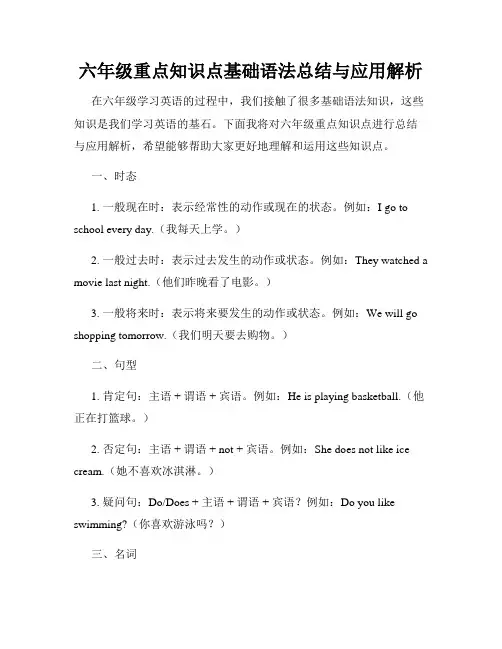
六年级重点知识点基础语法总结与应用解析在六年级学习英语的过程中,我们接触了很多基础语法知识,这些知识是我们学习英语的基石。
下面我将对六年级重点知识点进行总结与应用解析,希望能够帮助大家更好地理解和运用这些知识点。
一、时态1. 一般现在时:表示经常性的动作或现在的状态。
例如:I go to school every day.(我每天上学。
)2. 一般过去时:表示过去发生的动作或状态。
例如:They watched a movie last night.(他们昨晚看了电影。
)3. 一般将来时:表示将来要发生的动作或状态。
例如:We will go shopping tomorrow.(我们明天要去购物。
)二、句型1. 肯定句:主语 + 谓语 + 宾语。
例如:He is playing basketball.(他正在打篮球。
)2. 否定句:主语 + 谓语 + not + 宾语。
例如:She does not like ice cream.(她不喜欢冰淇淋。
)3. 疑问句:Do/Does + 主语 + 谓语 + 宾语?例如:Do you like swimming?(你喜欢游泳吗?)三、名词1. 可数名词:表示可以用数目计算的事物。
例如:two books(两本书)2. 不可数名词:表示无法用数目计算的事物。
例如:water(水)四、形容词形容词用于修饰名词,表示事物的特征或状态。
1. 比较级:用于比较两个事物的特征或状态,形式为原级 + er。
例如:She is taller than me.(她比我高。
)2. 最高级:用于描述三个或三个以上事物之间的比较,形式为the + 原级 + est。
例如:This is the tallest building in the city.(这是城里最高的建筑物。
)五、副词副词用于修饰动词、形容词或其他副词,表示时间、地点、程度等概念。
1. 时间副词:表示动作发生的时间。
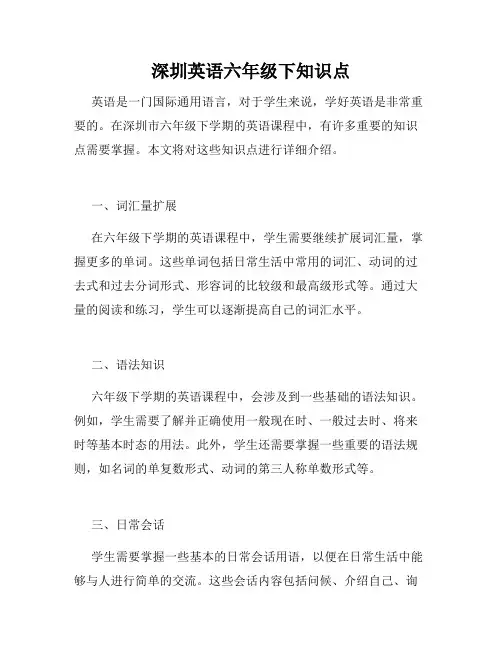
深圳英语六年级下知识点英语是一门国际通用语言,对于学生来说,学好英语是非常重要的。
在深圳市六年级下学期的英语课程中,有许多重要的知识点需要掌握。
本文将对这些知识点进行详细介绍。
一、词汇量扩展在六年级下学期的英语课程中,学生需要继续扩展词汇量,掌握更多的单词。
这些单词包括日常生活中常用的词汇、动词的过去式和过去分词形式、形容词的比较级和最高级形式等。
通过大量的阅读和练习,学生可以逐渐提高自己的词汇水平。
二、语法知识六年级下学期的英语课程中,会涉及到一些基础的语法知识。
例如,学生需要了解并正确使用一般现在时、一般过去时、将来时等基本时态的用法。
此外,学生还需要掌握一些重要的语法规则,如名词的单复数形式、动词的第三人称单数形式等。
三、日常会话学生需要掌握一些基本的日常会话用语,以便在日常生活中能够与人进行简单的交流。
这些会话内容包括问候、介绍自己、询问他人情况、请求帮助等。
通过与同学或老师进行实际对话练习,学生可以提高自己的口语表达能力。
四、阅读能力在六年级下学期的英语课程中,学生需要通过阅读短文来提高自己的阅读能力。
这些短文内容涵盖了日常生活、校园生活、动物、食物等多个方面。
通过阅读,学生可以了解到不同的文化背景,扩展自己的知识面。
五、听力技巧听力是学习英语时必不可少的一项技能。
在六年级下学期的英语课程中,学生将继续进行听力训练。
学生需要通过听力材料,如录音和教师的口语表达,来提高自己的听力理解能力。
通过反复听听力材料并进行相关练习,学生可以逐渐提高自己的听力技巧。
六、写作能力在六年级下学期的英语课程中,学生需要提高自己的写作能力。
学生需要能够正确地运用所学的词汇和语法知识,写出简单的句子和段落。
通过不断练习写作,学生可以提高自己的写作水平,增强表达能力。
总结:深圳英语六年级下学期的知识点包括词汇量扩展、语法知识、日常会话、阅读能力、听力技巧和写作能力。
通过系统学习和不断的练习,学生可以全面提升自己的英语水平,更好地应对日常学习和交流中的英语问题。
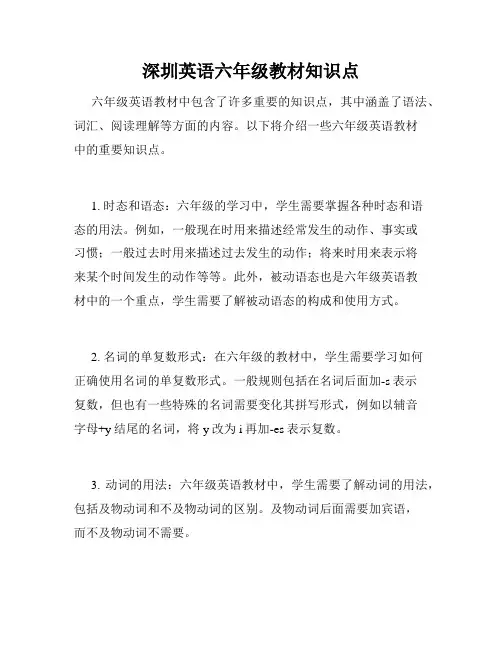
深圳英语六年级教材知识点六年级英语教材中包含了许多重要的知识点,其中涵盖了语法、词汇、阅读理解等方面的内容。
以下将介绍一些六年级英语教材中的重要知识点。
1. 时态和语态:六年级的学习中,学生需要掌握各种时态和语态的用法。
例如,一般现在时用来描述经常发生的动作、事实或习惯;一般过去时用来描述过去发生的动作;将来时用来表示将来某个时间发生的动作等等。
此外,被动语态也是六年级英语教材中的一个重点,学生需要了解被动语态的构成和使用方式。
2. 名词的单复数形式:在六年级的教材中,学生需要学习如何正确使用名词的单复数形式。
一般规则包括在名词后面加-s表示复数,但也有一些特殊的名词需要变化其拼写形式,例如以辅音字母+y结尾的名词,将y改为i再加-es表示复数。
3. 动词的用法:六年级英语教材中,学生需要了解动词的用法,包括及物动词和不及物动词的区别。
及物动词后面需要加宾语,而不及物动词不需要。
4. 形容词和副词的比较级和最高级:在六年级英语教材中,学生需要学会形容词和副词的比较级和最高级的构成和用法。
一般形容词和副词比较级的构成方式是在词尾加-er,最高级的构成方式是在词尾加-est。
但也有一些特殊情况需要变化拼写形式。
5. 句型转换和句子的连贯性:六年级英语教材中,学生需要学会通过句型转换来改写句子,例如变为否定句、疑问句等。
此外,学生还需要注意句子的连贯性,使用适当的连词或短语来表达句子之间的关系,使文章更加通顺流畅。
6. 阅读理解:六年级英语教材中的阅读理解部分涵盖了各种不同类型的文章,如记叙文、说明文、对话等。
学生需要通过阅读理解来获取信息、回答问题,并理解文章中的主旨和细节。
以上是六年级英语教材中的一些重要知识点。
通过系统学习这些知识点,学生可以提高英语应用能力,更好地理解和运用英语。
在学习过程中,学生可以多做练习题,加强对知识点的掌握和运用。
同时,培养英语阅读习惯也是十分重要的,可以通过多读英语故事书、文章等来提高自己的阅读能力和理解能力。
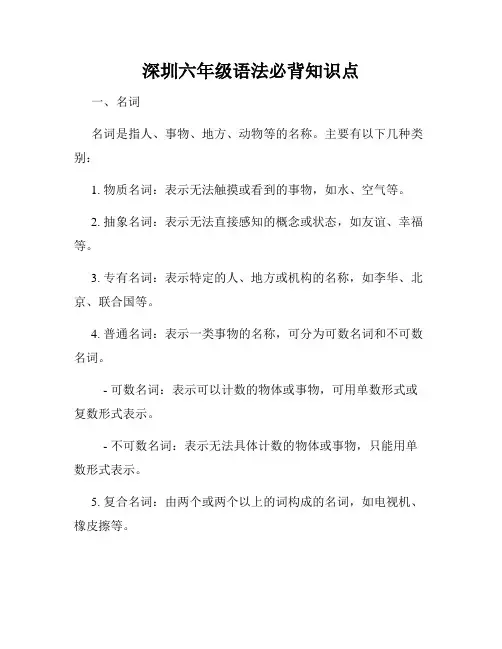
深圳六年级语法必背知识点一、名词名词是指人、事物、地方、动物等的名称。
主要有以下几种类别:1. 物质名词:表示无法触摸或看到的事物,如水、空气等。
2. 抽象名词:表示无法直接感知的概念或状态,如友谊、幸福等。
3. 专有名词:表示特定的人、地方或机构的名称,如李华、北京、联合国等。
4. 普通名词:表示一类事物的名称,可分为可数名词和不可数名词。
- 可数名词:表示可以计数的物体或事物,可用单数形式或复数形式表示。
- 不可数名词:表示无法具体计数的物体或事物,只能用单数形式表示。
5. 复合名词:由两个或两个以上的词构成的名词,如电视机、橡皮擦等。
二、代词代词是用来代替名词或名词短语的词语。
根据其在句子中的作用和指代的范围,代词可分为以下几种类型:1. 人称代词:用来指代人或事物,包括第一、第二、第三人称,如我、你、他。
2. 物主代词:用来表示所属关系,包括形容词性物主代词和名词性物主代词,如我的、他的。
3. 指示代词:用来指示人或事物的位置或指代的范围,包括近指代词和远指代词,如这、那。
4. 疑问代词:用于提问代替被询问的人或事物,包括主格和宾格形式,如谁、什么。
5. 不定代词:用来泛指不具体的人或事物,包括所有格不定代词和指示不定代词,如一些、任何。
三、动词动词是表示人或事物的动作、状态或存在的词汇。
根据其所表达的时间情态可以分为以下几种类型:1. 实义动词:表示具体的动作、行为或状态,如跑、吃、看等。
2. 系动词:用来表示主语的状态或特征,如是、变成等。
3. 助动词:用来帮助主要动词构成各种时态或情态,如can、will等。
4. 情态动词:用来表示说话人的情态、意愿、推测等态度,如should、might等。
四、形容词形容词是用来修饰名词或代词的词语。
它可以描述事物的性质、特征、状态等。
形容词一般放在名词前面,也可用于表语和补足语的位置。
常见的形容词有美丽、高大、快乐等。
五、副词副词是用来修饰动词、形容词、副词或整个句子的词语。
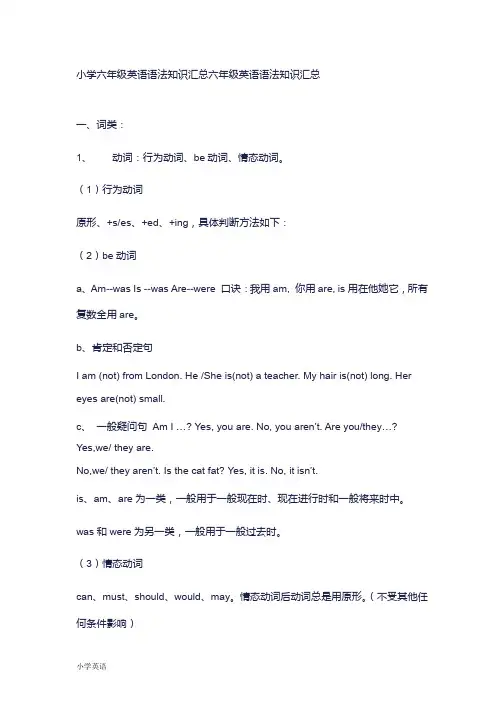
小学六年级英语语法知识汇总六年级英语语法知识汇总一、词类:1、动词:行为动词、be动词、情态动词。
(1)行为动词原形、+s/es、+ed、+ing,具体判断方法如下:(2)be动词a、Am--was Is --was Are--were 口诀:我用am, 你用are, is用在他她它,所有复数全用are。
b、肯定和否定句I am (not) from London. He /She is(not) a teacher. My hair is(not) long. Her eyes are(not) small.c、一般疑问句Am I …? Yes, you are. No, you aren’t. Are you/they…? Yes,we/ they are.No,we/ they aren’t. Is the cat fat? Yes, it is. No, it isn’t.is、am、are为一类,一般用于一般现在时、现在进行时和一般将来时中。
was和were为另一类,一般用于一般过去时。
(3)情态动词can、must、should、would、may。
情态动词后动词总是用原形。
(不受其他任何条件影响)2.名词这里强调两点:不可数名词都默认为单数,所以总是用is或者was。
如何加后缀:a.一般情况下,直接加-s,如:book-books, bag-bags, cat-cats, bed-bedsb.以s. x. sh. ch结尾,加-es,如:bus-buses, box-boxes, brush-brushes, watch-watchesc.以“辅音字母+y”结尾,变y为i, 再加-es,如:family-families, strawberry-strawberriesd.以“f或fe”结尾,变f或fe为v, 再加-es,如:knife-knivese.不规则名词复数:man-men, woman-women, policeman-policemen, policewoman-policewomen, mouse-mice child-children foot-feet ,.tooth-teeth fish-fish, people-people, Chinese-Chinese, Japanese-Japanese3.形容词(包括副词)形容词表示某一事物或的特征,副词表示某一动作的特征。
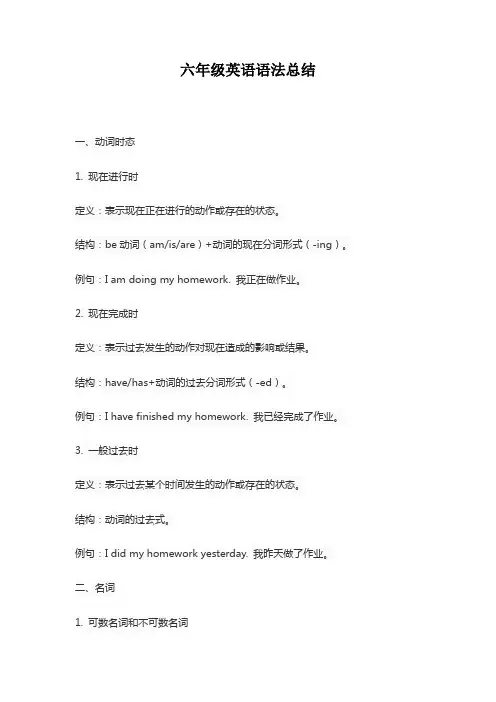
六年级英语语法总结一、动词时态1. 现在进行时定义:表示现在正在进行的动作或存在的状态。
结构:be动词(am/is/are)+动词的现在分词形式(-ing)。
例句:I am doing my homework. 我正在做作业。
2. 现在完成时定义:表示过去发生的动作对现在造成的影响或结果。
结构:have/has+动词的过去分词形式(-ed)。
例句:I have finished my homework. 我已经完成了作业。
3. 一般过去时定义:表示过去某个时间发生的动作或存在的状态。
结构:动词的过去式。
例句:I did my homework yesterday. 我昨天做了作业。
二、名词1. 可数名词和不可数名词可数名词:可以计数的名词,如book(书)、apple(苹果)。
不可数名词:无法计数的名词,如water(水)、milk(牛奶)。
2. 名词的复数形式大多数名词的复数形式是在词尾加上s或es,如books、apples。
三、代词1. 人称代词:表示人称的代词,如I(我)、you(你)、he(他)、she(她)。
2. 物主代词:表示所有关系的代词,如my(我的)、your(你的)、his(他的)、hers(她的)。
四、形容词和副词1. 形容词:用来描述名词或代词的性质或特征,如red(红色的)、big(大的)。
2. 副词:用来描述动词、形容词或其他副词的程度或方式,如slowly(慢慢地)、quickly(快速地)。
五、介词1. 表示时间的介词:如in(在...里)、on(在...上)、at(在...点)。
2. 表示位置的介词:如in(在...内)、on(在...上)、at(在...处)。
六、定冠词和不定冠词1. 定冠词:表示特指,如the(这个)、that(那个)。
2. 不定冠词:表示泛指,如a(一个)、an(一个)。
七、句式结构1. 陈述句:陈述一个事实或观点,如I am a student.(我是一个学生。
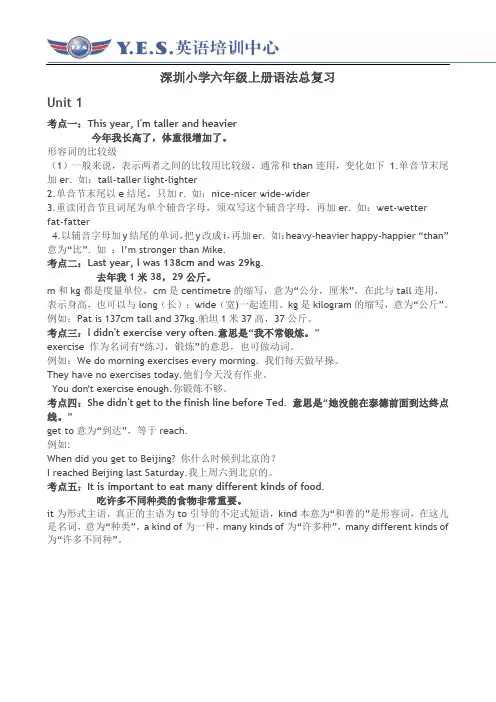
深圳小学六年级上册语法总复习Unit 1考点一:This year, I'm taller and heavier今年我长高了,体重很增加了。
形容词的比较级(1)一般来说,表示两者之间的比较用比较级,通常和than连用,变化如下1.单音节末尾加er. 如:tall-taller light-lighter2.单音节末尾以e结尾,只加r. 如:nice-nicer wide-wider3.重读闭音节且词尾为单个辅音字母,须双写这个辅音字母,再加er. 如:wet-wetterfat-fatter4.以辅音字母加y结尾的单词,把y改成i,再加er. 如:heavy-heavier happy-happier “than”意为“比”. 如:I’m stronger than Mike.考点二:Last year, l was 138cm and was 29kg.去年我1米38,29公斤。
m和kg都是度量单位,cm是centimetre的缩写,意为“公分,厘米”,在此与tall连用,表示身高,也可以与long(长);wide(宽)一起连用。
kg是kilogram的缩写,意为“公斤”。
例如:Pat is 137cm tall and 37kg.帕坦1米37高,37公斤。
考点三:l didn't exercise very often.意思是“我不常锻炼。
”exercise 作为名词有“练习,锻炼”的意思,也可做动词。
例如:We do morning exercises every morning. 我们每天做早操。
They have no exercises today.他们今天没有作业。
You don't exercise enough.你锻炼不够。
考点四:She didn't get to the finish line before Ted. 意思是“她没能在泰德前面到达终点线。
小学六年级英语语法知识点汇总一、动词的时态动词的时态表示动作或状态发生的时间。
常见的动词时态有以下几种:1. 一般现在时一般现在时表示经常性的动作或存在的状态。
例句:She goes to school every day.(她每天去学校。
)2. 一般过去时一般过去时表示过去发生的动作或存在的状态。
例句:I ate an apple yesterday.(昨天我吃了一个苹果。
)3. 一般将来时一般将来时表示将来要发生的动作或存在的状态。
例句:We will have a party next week.(我们下周要开一个派对。
)二、名词的单数和复数形式名词用来表示人、事物、地点等,在句子中具有主语、宾语、表语等作用。
名词的单数形式和复数形式有以下规则:1. 一般名词的复数形式大多数一般名词在末尾加-s表示复数。
例句:apple - apples(苹果)2. 以s、x、ch、sh结尾的名词以-s、-x、-ch、-sh结尾的名词,复数形式在末尾加-es。
例句:bus - buses(公共汽车)3. 以辅音字母+y结尾的名词以辅音字母+y结尾的名词,将y变为i,再加-es。
例句:baby - babies(宝宝)三、形容词的比较级和最高级形容词用来描述或修饰名词。
形容词的比较级和最高级有以下形式:1. 比较级的构成形容词比较级的构成通常在词尾加-er。
例句:tall - taller(高)2. 最高级的构成形容词最高级的构成通常在词尾加-est。
例句:tall - tallest(最高的)四、冠词的用法冠词用来修饰名词,有三个基本形式:不定冠词a/an、定冠词the和零冠词。
1. 不定冠词a/an不定冠词a/an用来表示泛指的意思,在单数名词前用a,在以辅音音素开头的单数名词前用an。
例句:a car(一辆汽车);an apple(一个苹果)2. 定冠词the定冠词the用来表示特指的意思,在特定的名词前使用。
六年级英语语法大全一、词类:动词、名词与形容词不太容易区分,如不能一眼瞧出,可用如下方法:先用“一(量词)”(如:一个、一张等)与这个词连起来说,如说得通,一般认为就是名词;说不通再用“很”去判断,就就是把“很”与为个词连起来说,说得通一般就就是形容词;都说不通就就是动词。
(目前我们学过的,以后可能不同)(另外一些很明显的,如人称代词、数词、情态动词等一下就可以知道)1、动词这里所说的动词就是指各种动词总称,其中包括行为动词(就就是我们平时总说的那种动词)、be动词、情态动词。
(1)行为动词就就是我们平时上课时说的动词,表示某一动作或行为。
如:sweep、live等。
行为动词我们已学过它们的四种形式:原形、+s/es、+ed、+ing,具体判断方法如下:↗有,就加ing读句子→读该单词→认识该单词→理解意思→瞧有无be动词(若就是be going to 就用原形)↘没有,再瞧情态动词↗有,就用原形↗有,就加ed↘没有,再瞧有无表示过去的时间状语↗就是第三人称单数就加s或es↘没有,再瞧主语↘不就是第三人称单数就用原形(2)be动词a、Am--was Is --was Are--were 口诀:我用am, 您用are, is用在她她它,所有复数全用are。
b、肯定与否定句 I am (not) from London、 He is(not) a teacher、 She is(not) in the dining room、 My hair is(not) long、 Her eyes are(not) small、c、一般疑问句 Am I a Chinese? Yes, you are、No, you aren’t、 Are they American? Yes, they are、No, they aren’t、 Is the cat fat? Yes, it is、No, it isn’t、我们现在学过的be动词大致分两类:is、am、are为一类,一般用于一般现在时、现在进行时与一般将来时中,was与were为另一类,一般用于一般过去时。
六年级英语知识点深圳在深圳的六年级英语课程中,学生将接触到许多重要的知识点。
这些知识点涵盖了语法、词汇、听力和口语等方面。
在下面的文章中,我们将对一些六年级英语知识点进行深入探讨。
1. 时态和动词形式在六年级英语中,学生将学习使用过去式、现在进行时和将来时等不同的时态。
他们也将掌握动词的基本形式和不规则动词的变化规则。
2. 名词和冠词学生将学习识别和使用不同类型的名词,如可数名词、不可数名词、单数名词和复数名词。
他们还将学会正确使用不同的冠词,如"a"和"an"。
3. 代词和人称代词学生将学习使用代词代替名词,以避免重复。
他们还将学会正确使用人称代词,如"I"、"you"、"he"、"she"、"it"、"we"和"they"。
4. 形容词和副词在六年级英语中,学生将学习描述事物的能力。
他们将学习形容词的用法,并了解形容词在句子中的位置。
此外,他们还将学习使用副词来修饰动词、形容词和其他副词。
5. 介词和介词短语学生将学习在句子中正确使用介词和介词短语。
他们将了解不同的介词及其在句子中的作用。
例如,在描述位置时使用介词“in”、“on”和“under”。
6. 疑问句和回答学生将学习构建疑问句并提问题。
他们还将学习回答这些问题,并使用适当的回答句型,如"Yes,I do"或"No,I don't"。
7. 语法规则和语句结构学生将学习句子的基本结构,并了解主语、谓语和宾语之间的关系。
他们还将学习修饰词的用法,并使用逗号和句号等标点符号正确地组织句子。
8. 听力和口语能力在深圳的六年级英语课程中,学生将进行大量的听力训练。
他们将学习听取并理解日常会话,以及回答与所听内容相关的问题。
深圳六年级下册英语知识点第一章:单词拼写1. 词汇量的积累非常重要。
学生们应该努力记住一些常见的词汇,尤其是课本中出现的单词。
2. 单词的拼写也是需要重点关注的。
要学会正确地拼写常用单词,避免拼写错误给理解和表达带来困扰。
3. 练习使用词典来查询生词和短语的意思及用法,这将有助于词汇的积累和扩展。
第二章:语法1. 学习并掌握基本的句子结构和语法规则,例如主语、谓语和宾语的概念与正确使用。
2. 了解不同时态的用法,如一般现在时、一般过去时和一般将来时等。
3. 学习形容词和副词的比较级和最高级用法,并能正确运用于句子中。
第三章:阅读理解1. 一定要培养起良好的阅读习惯。
常阅读英语文章、故事以及报刊杂志等,提高理解能力和词汇量。
2. 理解文章主题及段落大意是阅读理解的关键。
学生们要学会找出关键词和重要信息,并运用推理将其组织起来。
3. 切勿死背阅读材料,要通过理解和分析文章的意思来回答问题。
第四章:口语表达1. 学生们应该多加练习口语表达,如日常问候、介绍自己、询问他人情况等。
2. 学会用简单的句子进行交流,并能流利地用英语描述自己的经历、爱好和计划等。
3. 鼓励学生们多参与口语练习活动,如角色扮演、小组讨论等,提高英语口语表达的能力。
第五章:听力技巧1. 听力是英语学习中非常重要的一部分。
学生们应该经常进行听力练习,提高听力理解能力。
2. 重视听力材料中的关键词和语境信息,从而理解和捕捉主要内容。
3. 多听一些英语对话和新闻,模仿其中的语音语调,提高自己的听力水平。
第六章:写作技巧1. 练习写作,培养写作的兴趣和能力,如写日记、写作文等。
2. 学习一些常用的写作句型和表达方式,丰富自己的语言功底。
3. 注意结构合理、逻辑清晰,以及正确使用句型和词汇来表达自己的观点和想法。
第七章:语音和发音1. 学习正确发音和语音规则,如元音和辅音的发音方式。
2. 注意语音的语调和重音,这对于准确表达和理解非常重要。
六年级英语语法点整理
以下是六年级英语的一些主要语法点:
1. 现在进行时:表示正在发生的动作。
结构为“be (am/is/are) + -ing”形式。
2. 一般现在时:描述日常习惯、能力和事实。
结构为“动词原形 + (第三人称单数时加-s/-es)。
3. 一般过去时:描述过去的事件或动作。
结构为“动词的过去式”。
4. 一般将来时:描述将来会发生的事件或动作。
结构为“will + 动词原形”或“be going to + 动词原形”。
5. 形容词的比较级和最高级:形容词用来描述名词的特性,比较级和最高级表示比较关系。
6. 副词的比较级和最高级:副词用来描述动词、形容词或其他副词的强度、频率或时间。
7. 介词:表示名词或代词与句子其他部分之间的关系,如“在、到、从、对于、通过”等。
8. 代词:代替名词或名词短语,例如“我、你、他、她、它、我们、他们”等。
9. 冠词:用在名词前,表示该名词的种类。
例如“a”用于元音发音开头的单词,“an”用于元音发音开头的单词,“the”用于特指。
10. 连词:用于连接词、短语或从句,表示它们之间的关系,如“和、但是、因为、所以”等。
以上是六年级英语的一些主要语法点,通过掌握这些语法点,学生可以更好地理解英语句子结构,提高阅读和写作能力。
深圳六年级语法知识点总结语法作为语言的基础,对于学习者来说是非常重要的。
在六年级,学生们需要掌握并灵活运用各种语法知识,以提高他们的语言表达能力。
下面是深圳六年级语法知识点的总结。
一、名词名词是用来表示人、事物、地方、动物等具体或抽象概念的词语。
名词可以分为可数名词和不可数名词两种。
可数名词指的是可以用数目来计量的名词,例如:book(书)、desk(桌子)等。
可数名词有单数形式和复数形式。
不可数名词指的是无法用数目来计量的名词,例如:water (水)、milk(牛奶)等。
不可数名词通常没有复数形式。
二、代词代词用来代替名词,在句子中起到指称或代替的作用。
代词可以分为人称代词、物主代词、指示代词、疑问代词等。
人称代词用来表示人称身份,例如:I(我)、you(你)、he (他)等。
物主代词用来表示所有关系,例如:my(我的)、your(你的)、his(他的)等。
指示代词用来指示人或事物,例如:this(这个)、that(那个)等。
疑问代词用来提问,例如:who(谁)、what(什么)等。
三、动词动词是表示动作、状态或存在的词语。
动词可以分为及物动词和不及物动词。
及物动词指的是需要接宾语才能表达完整意义的动词,例如:eat(吃)、drink(喝)等。
不及物动词指的是不需要接宾语就能表达完整意义的动词,例如:run(跑)、sleep(睡觉)等。
动词的时态分为过去时、现在时和将来时。
有些动词还需要用助动词来构成完成时态和进行时态。
四、形容词和副词形容词用来描述名词的特征和性质,例如:big(大)、beautiful(漂亮)等。
副词用来修饰动词、形容词和其他副词,用来表示程度、方式等,例如:quickly(快速地)、happily(开心地)等。
形容词和副词有原级、比较级和最高级三种形式,用来表示不同程度的描述。
五、介词介词用来在句子中表示名词与其他词之间的关系,例如:in (在)、on(在……上)等。
介词通常位于名词或代词之前,用来修饰或连接其他词语。
六年级英语语法大全一、词类:动词、名词和形容词不太容易区分,如不能一眼看出,可用如下方法:先用“一(量词)”(如:一个、一张等)和这个词连起来说,如说得通,一般认为是名词;说不通再用“很”去判断,就是把“很”和为个词连起来说,说得通一般就是形容词;都说不通就是动词。
(目前我们学过的,以后可能不同)(另外一些很明显的,如人称代词、数词、情态动词等一下就可以知道)1、动词这里所说的动词是指各种动词总称,其中包括行为动词(就是我们平时总说的那种动词)、be动词、情态动词。
(1)行为动词就是我们平时上课时说的动词,表示某一动作或行为。
如:sweep、live等。
行为动词我们已学过它们的四种形式:原形、+s/es、+ed、+ing,具体判断方法如下:↗有,就加ing读句子→读该单词→认识该单词→理解意思→看有无be动词(若是be going to 就用原形)↘没有,再看情态动词↗有,就用原形↗有,就加ed↘没有,再看有无表示过去的时间状语↗是第三人称单数就加s或es↘没有,再看主语↘不是第三人称单数就用原形(2)be动词a、Am--was Is --was Are--were 口诀:我用am, 你用are, is用在他她它,所有复数全用are。
b、肯定和否定句 I am (not) from London. He is(not) a teacher. She is(not) in the dining room. My hair is(not) long. Her eyes are(not) small.c、一般疑问句Am I a Chinese? Yes, you are. No, you aren’t. Are they American? Yes, they are. No, they aren’t. Is the cat fat? Yes, it is. No, it isn’t.我们现在学过的be动词大致分两类:is、am、are为一类,一般用于一般现在时、现在进行时和一般将来时中,was和were为另一类,一般用于一般过去时。
判断步骤:↗第一、三人称单数,就用was↗有,再看人称↘第二人称单数和所有复数,就用were看有无表示过去的时间状语↗第一人称单数,就用am↘没有,再看人称→第三人称单数,就有is↘第二人称单数和所有复数,就用are(3)情态动词情态动词也是一类特殊的动词,平时我们不把它说成是动词。
情态动词可以和行为动词同时出现在同一个句子中。
我们现在学过的情态动词有:can、must、should、would、may。
接触最多的是can。
情态动词后动词总是用原形。
(不受其他任何条件影响)2、名词表示某一事物,有具体的和抽象的之分。
判断的关键词往往是be动词,be动词如果是am、is或was,名词就用原形;be动词如果是are或were,名词就加s 或es。
这里强调两点:不可数名词都默认为单数,所以总是用is或者was;最好不要根据some、any、a lot of等词去作判断,以免受误导。
如何加后缀:a.一般情况下,直接加-s,如:book-books, bag-bags, cat-cats, bed-bedsb.以s. x. sh. ch结尾,加-es,如:bus-buses, box-boxes, brush-brushes, watch-watchesc.以“辅音字母+y”结尾,变y为i, 再加-es,如:family-families, strawberry-strawberriesd.以“f或fe”结尾,变f或fe为v, 再加-es,如:knife-knivese.不规则名词复数: man-men, woman-women, policeman-policemen, policewoman-policewomen, mouse-mice child-childrenfoot-feet ,.tooth-teeth fish-fish, people-people, Chinese-Chinese, Japanese-Japanese判断步骤:↗如是am、is或was→原形读句子→读该单词→认识该单词→理解意思→看be动词↘如是are或were→加s或es3、形容词(包括副词)形容词表示某一事物或的特征,副词表示某一动作的特征。
形容词和副词只有两种形式:原形和+er。
未作比较的情况下就用原形,比较时就+er。
两个重要特征:as……as中间一定用原形,有than的时候一定+er。
4、人称代词和物主代词人称代词:有主格和宾格之分。
一般动词前用主格,动词后用宾格。
物主代词:有两类:形容词性物主代词(短的)和名词性物主代词(长的)一般看后面有没有名词,如有,就用形容词性物主代词(短的);如无,就用名词性物主代词(长的)。
5、数量词我们学过两类:基数词和序数词。
基数用于表示数量多少,而基数词用于表示次序,常在日期中出现。
6、冠词有a、an、the。
a和an有具体的意思,一(个…),the没有具体意思,有时翻译为这、那。
确定用a、an还是the时可根据汉语意思。
a和an的区别:an 用于元音音素(一般就是元音字母aeiou)前,a用于辅音音素前。
二、否定句:表示某一否定意思。
句中一定有not。
有三种可能:be动词(am、is、are、was、were)+not、情态动词(can、must、should)+ not、助动词(do、does、did) + not如何将一个肯定的陈述句改为否定句:1、看句中有无be动词,如有,直接在be动词后+ not。
2、看句中有无情态动词,如有,直接在情态动词后+ not。
3、如上述二者都没有,就应用助动词+ not。
分四个步骤:(1)肯定陈述句中本来是没有助动词的,要加上去,位置在主语(某人/某物)后,动词前。
(2)确定助动词用do、does还是did,根据句中动词,动词是原形的助动词就用do,动词是第三人称单数的助动词就用does,动词用过去式的助动词就有did。
(3)在助动词后加not。
(4)原句中动词假如发生变化就要恢复成原形。
强调一点,有some的要考虑是否要用any。
三、一般疑问句。
表示疑问,一般回答只有两种可能Yes,……或No,……句中没有疑问词。
如何将一个肯定的陈述句改为否定句:1、看句中有无be动词,如有,把be动词提到句首即可。
2、看句中有无情态动词,如有,把情态动词提到句首即可。
3、如上述二者都没有,就应把助动提到句首。
分四个步骤:(1)肯定陈述句中本来是没有助动词的,要加上去,位置在主语(某人/某物)后,动词前。
(2)确定助动词用do、does还是did,根据句中动词,动词是原形的助动词就用do,动词是第三人称单数的助动词就用does,动词用过去式的助动词就有did。
(3)把助动词后提到句首。
(4)原句中动词假如发生变化就要恢复成原形。
强调一点,有some的要考虑是否要用any。
四、特殊疑问句。
表示疑问,有疑问词(在开头),回答有很多种可能。
常用疑问词:What、When、Which、Who、Whose、Why、How如何对划线部分提问:1、将原问句翻译为汉语(在读中要将划线部分重读)。
如:His birthday is on the 5th of May . 他的生日在五月五日。
2、用汉语进行提问。
如上句,应该问:他的生日在什么时候?3、根据汉语将所要提问的句子补充完整。
如上句When is his birthday ?五、祈使句表示请求或命令别人做某事或不要做某事。
肯定祈使句一定是以动词原形开头(有时有please),否定的祈使句一定是don’t加动词原形开头(有时有please)。
把祈使句改为否定句只需在动词前加don’t即可。
六、时态1、一般现在时(1)句中be动词和动词一般情况下只能有一种而且也必须有一种。
如:The children are very happy on Christmas Day .She often does some housework at the weekend .(2)一般现在时中的be动词:一般用原形:am is aream用于第一人称单数(I);is用于第三人称单数(he she it和其他人名或称谓,如:Ben his sister等);are用于第二人称单数(you)和所有复数(包括第一人称复数we、第二人称复数you;第三人称复数they和其他复数,如the children 、 his parents等)。
(3)一般过去时中的动词:有两种情况:第一种情况:主语是第三人称单数(he she it 和其他,如Helen 、her cousin 等),动词后一般加s或es。
第二种情况:主语不是第三人称单数,动词都用原形。
(4)一般现在时判断依据(如何判断一个句子是一般现在时):△be动词是am、is、are△动词用原形或加s、es△没有时间状语或有usually、often、everyday、sometimes等不是具体的时间(5)有用的的依据:Be动词是is、am ←→ 名词用原形(这里包括可数名词的单数和不可数名词)Be动词是are ←→ 名词加s或es动词加s或es ←→ 主语是第三人称单数动词用原形←→ 主语不是第三人称单数(6)情态动词:我们现在学过的情态动词有:can、must、should、would。
情态动词后动词总是用原形。
(不受其他任何条件影响)2、一般过去时(1)句中be动词和动词一般情况下只能有一种而且也必须有一种。
如:The girls were on the grass just now .They visited my parents last weekend .(2)一般过去时中的be动词:一般用过去式:was werewas用于第一人称单数(I)和第三人称单数(he she it和其他人名或称谓,如:Ben 、 his sister等);were用于第二人称单数(you)和所有复数(包括第一人称复数we、第二人称复数you;第三人称复数they和其他复数,如the children 、 his parents等)。
(3)一般过去时中的动词:一般只有一种情况:+ed这里强调一点,和一般现在时不同的是这里不管主语是第几人称,也不管是单数和复数都加ed。
(4)一般过去时判断依据(如何判断一个句子是一般过去时):△be动词是was、were△动词加ed△有表示过去的时间状语现在学过的常用的表示过去的时间状语有:just now , a moment ,yesterday , last week , l ast night,last weekend , last year ,last month , three days ago , two weeks ago ,five years ago(5)有用的的依据:Be动词是was或were 该句是一般过去时动词加ed 有表示过去的时间状语3、一般将来时(1)构成形式:Be going to +动词原形。